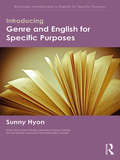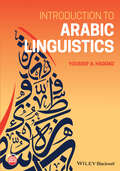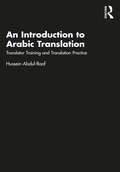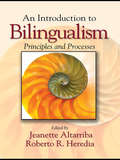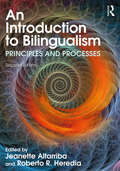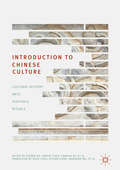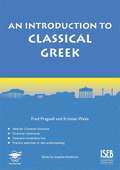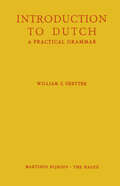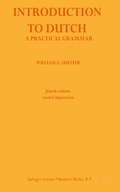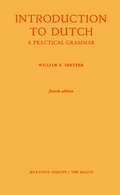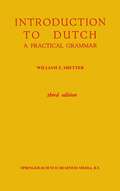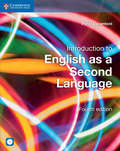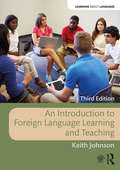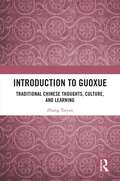- Table View
- List View
Introducing English for Specific Purposes (Routledge Introductions to English for Specific Purposes)
by Laurence AnthonyIntroducing English for Specific Purposes presents the key concepts and practices of ESP in a modern, balanced, and comprehensive way. This book defines ESP and shows how the approach plays a crucial role in the world of English language teaching. Explaining how needs analysis, language and learning objectives, materials and methods, and evaluation combine to form the four main pillars of ESP, the book includes: practical examples that illustrate how the core theories and practices of ESP can be applied in real-world academic and occupational settings; discussion of some of the most hotly debated issues in ESP; insights on how ESP courses can be organized and integrated to form a complete program; reflection boxes, practical tasks, extension research questions, and resources for further reading in each chapter. Introducing English for Specific Purposes serves as an ideal textbook for graduate and advanced undergraduate students studying courses on English for Specific Purposes or English for Academic Purposes, as part of degrees in English for Specific Purposes, Education, ELT, Applied Linguistics, TESOL or TEFL. This comprehensive publication is also an invaluable reference resource for pre-service and in-service teachers of ESP, and for English program managers and administrators.
Introducing Genre and English for Specific Purposes (Routledge Introductions to English for Specific Purposes)
by Sunny HyonGenre analysis has become a key approach within the field of English for Specific Purposes and helps students understand particular language use patterns in target contexts. Introducing Genre and English for Specific Purposes provides an overview of how genre has been conceptualized and applied in ESP, as well as the features that distinguish ESP genre research and teaching from those of other genre schools. The macro and micro aspects of ESP genre-based pedagogy are also analysed and include: different possibilities for planning and designing an ESP genre-based course; the concrete, micro aspects of materials creation; and how genres can be learned through play. Introducing Genre and English for Specific Purposes is essential reading for students and pre-service teachers who are studying Genre, English for Specific Purposes or language teaching methodologies.
Introducing Genre and English for Specific Purposes (Routledge Introductions to English for Specific Purposes)
by Sunny HyonGenre analysis has become a key approach within the field of English for Specific Purposes and helps students understand particular language use patterns in target contexts. Introducing Genre and English for Specific Purposes provides an overview of how genre has been conceptualized and applied in ESP, as well as the features that distinguish ESP genre research and teaching from those of other genre schools. The macro and micro aspects of ESP genre-based pedagogy are also analysed and include: different possibilities for planning and designing an ESP genre-based course; the concrete, micro aspects of materials creation; and how genres can be learned through play. Introducing Genre and English for Specific Purposes is essential reading for students and pre-service teachers who are studying Genre, English for Specific Purposes or language teaching methodologies.
Introducing Researching English for Specific Purposes (Routledge Introductions to English for Specific Purposes)
by Lindy WoodrowIntroducing Researching English for Specific Purposes is an accessible and practical guide to research in ESP. It’s for novice researchers, graduate students and for ESP practitioners who want to do some research themselves. The author takes the reader step by step through the stages of research, starting with choosing a topic and reviewing the literature though to writing up research findings. Examples are taken from academic journals and dissertations to highlight aspects of the research process. The book covers the following areas: developing a research project research design theoretical approaches to ESP research choosing a research topic quantitative, qualitative and mixed methods in ESP research validity, reliability and ethics writing up research in ESP The book includes recommendations for further reading and tasks. There is also a glossary and a chapter providing advice, templates and links to useful research sources. Introducing Researching English for Specific Purposes is essential reading for anyone wanting to conduct research in ESP.
Introducing Researching English for Specific Purposes (Routledge Introductions to English for Specific Purposes)
by Lindy WoodrowIntroducing Researching English for Specific Purposes is an accessible and practical guide to research in ESP. It’s for novice researchers, graduate students and for ESP practitioners who want to do some research themselves. The author takes the reader step by step through the stages of research, starting with choosing a topic and reviewing the literature though to writing up research findings. Examples are taken from academic journals and dissertations to highlight aspects of the research process. The book covers the following areas: developing a research project research design theoretical approaches to ESP research choosing a research topic quantitative, qualitative and mixed methods in ESP research validity, reliability and ethics writing up research in ESP The book includes recommendations for further reading and tasks. There is also a glossary and a chapter providing advice, templates and links to useful research sources. Introducing Researching English for Specific Purposes is essential reading for anyone wanting to conduct research in ESP.
Introduction to Arabic Linguistics
by Youssef A. HaddadA comprehensive introduction to the linguistic fundamentals of modern Arabic, ideal for Arabic language learners as well as speakers interested in developing a richer understanding of language use and behavior Introduction to Arabic Linguistics presents a clear and engaging overview of the core linguistic aspects of modern Arabic, focusing on Modern Standard Arabic and Levantine Arabic. Designed to be welcoming for undergraduates without fluency in Arabic and for students with only limited familiarity with linguistics, this textbook covers all fundamental areas of Arabic linguistics. Detailed yet accessible chapters include comprehension and analysis questions, critical thinking exercises, application examples with authentic data, reading assignments, and classroom and homework projects. This valuable textbook is organized into three units which cover sounds and sound systems, word structure and meaning, and phrases and phrase structure. Author Youssef Haddad draws from both the Arabic grammatical tradition and recent linguistic research to provide students with a solid foundation in the linguistic features and structures of Arabic sounds, words, and phrases. Topics include phonological processes, derivational morphology, noun and verb phrases, sentence structure, structural ambiguity, and more. Discusses key topics in the formal study of Arabic linguistics, suitable for Arabic speakers and language learners Encourages students to investigate a dialect not covered in the book at different levels of linguistic analysis Answers many of the most common and relevant questions in the field of Arabic linguistics Includes a typological and historical overview of the Arabic language Offers an instructor’s website with additional exercises, practice questions, PowerPoint presentations, and answer keysIntroduction to Arabic Linguistics is the perfect textbook for undergraduates in modern language and linguistic courses and a valuable resource for graduate students in Arabic studies or linguistics programs.
Introduction to Arabic Linguistics
by Youssef A. HaddadA comprehensive introduction to the linguistic fundamentals of modern Arabic, ideal for Arabic language learners as well as speakers interested in developing a richer understanding of language use and behavior Introduction to Arabic Linguistics presents a clear and engaging overview of the core linguistic aspects of modern Arabic, focusing on Modern Standard Arabic and Levantine Arabic. Designed to be welcoming for undergraduates without fluency in Arabic and for students with only limited familiarity with linguistics, this textbook covers all fundamental areas of Arabic linguistics. Detailed yet accessible chapters include comprehension and analysis questions, critical thinking exercises, application examples with authentic data, reading assignments, and classroom and homework projects. This valuable textbook is organized into three units which cover sounds and sound systems, word structure and meaning, and phrases and phrase structure. Author Youssef Haddad draws from both the Arabic grammatical tradition and recent linguistic research to provide students with a solid foundation in the linguistic features and structures of Arabic sounds, words, and phrases. Topics include phonological processes, derivational morphology, noun and verb phrases, sentence structure, structural ambiguity, and more. Discusses key topics in the formal study of Arabic linguistics, suitable for Arabic speakers and language learners Encourages students to investigate a dialect not covered in the book at different levels of linguistic analysis Answers many of the most common and relevant questions in the field of Arabic linguistics Includes a typological and historical overview of the Arabic language Offers an instructor’s website with additional exercises, practice questions, PowerPoint presentations, and answer keysIntroduction to Arabic Linguistics is the perfect textbook for undergraduates in modern language and linguistic courses and a valuable resource for graduate students in Arabic studies or linguistics programs.
An Introduction to Arabic Translation: Translator Training and Translation Practice
by Hussein Abdul-RaofCombining theory and practice, this book is a model for Arabic translation and prepares students for the translation industry. Containing 22 approaches, An Introduction to Arabic Translation provides the normative principles to guide training in Arabic-English-Arabic translation. It revitalizes Arabic-English-Arabic translation through its empirical textual reality, hinged upon Arabic and English authentic contexts and their linguistic, discoursal, and cultural incongruity. The exercises in each chapter provide practical training supported by translation theory. The translation commentaries included represent a critical translation quality assessment based on an analysis of discourse and textual features to highlight the process of translation, the translation approach adopted, and why. Such commentary invites students to reflect on their understanding of the translation process and the approach required for a given Arabic-English-Arabic translation problem. Providing a methodologically comprehensive course of Arabic-English-Arabic translation studies, and insightful discussion of high value for both students and teachers, this book will be invaluable to anyone seeking to learn or improve their Arabic and translation skills.
An Introduction to Arabic Translation: Translator Training and Translation Practice
by Hussein Abdul-RaofCombining theory and practice, this book is a model for Arabic translation and prepares students for the translation industry. Containing 22 approaches, An Introduction to Arabic Translation provides the normative principles to guide training in Arabic-English-Arabic translation. It revitalizes Arabic-English-Arabic translation through its empirical textual reality, hinged upon Arabic and English authentic contexts and their linguistic, discoursal, and cultural incongruity. The exercises in each chapter provide practical training supported by translation theory. The translation commentaries included represent a critical translation quality assessment based on an analysis of discourse and textual features to highlight the process of translation, the translation approach adopted, and why. Such commentary invites students to reflect on their understanding of the translation process and the approach required for a given Arabic-English-Arabic translation problem. Providing a methodologically comprehensive course of Arabic-English-Arabic translation studies, and insightful discussion of high value for both students and teachers, this book will be invaluable to anyone seeking to learn or improve their Arabic and translation skills.
An Introduction to Bilingualism: Principles and Processes
by Jeanette Altarriba Roberto R. HerediaThis important text provides a general overview of the methods and theories used in the broad domain of bilingualism. The unique interdisciplinary approach, which is reflected in the various topics covered, gives students a global picture of the field. Topics range from early childhood intellectual development to educational and social-cognitive challenges to the maturing bilingual brain. Important developing areas such as cognitive aging, creativity, the social and cultural context perspective, communication disorders and sentence processing are also covered within the volume. This text is aimed towards undergraduate courses and graduate courses in psycholinguistics, especially those with an emphasis on bilingualism or second language learning.
An Introduction to Bilingualism: Principles and Processes
by Jeanette Altarriba Roberto R. HerediaThis important text provides a general overview of the methods and theories used in the broad domain of bilingualism. The unique interdisciplinary approach, which is reflected in the various topics covered, gives students a global picture of the field. Topics range from early childhood intellectual development to educational and social-cognitive challenges to the maturing bilingual brain. Important developing areas such as cognitive aging, creativity, the social and cultural context perspective, communication disorders and sentence processing are also covered within the volume. This text is aimed towards undergraduate courses and graduate courses in psycholinguistics, especially those with an emphasis on bilingualism or second language learning.
An Introduction to Bilingualism: Principles and Processes
by Jeanette Altarriba Roberto R. HerediaThe study of bilingualism and all of its aspects – from theory and models to social approaches and their practical applications – forms the cornerstone of the 2nd edition of this work. The chapters cover the latest advancements in the domains of psycholinguistics, neuroscience, creativity, and executive functioning. Contributions, new to this edition, offer the reader the most up-to-date research on lifespan and developmental issues. The work also provides insight into how human language is processed by all, not just by bilingual and multilingual speakers.This text is ideal for senior undergraduate and graduate courses in psycholinguistics and the psychology of language, especially those with an emphasis on bilingualism or second language learning.
An Introduction to Bilingualism: Principles and Processes
by Jeanette Altarriba and Roberto R. HerediaThe study of bilingualism and all of its aspects – from theory and models to social approaches and their practical applications – forms the cornerstone of the 2nd edition of this work. The chapters cover the latest advancements in the domains of psycholinguistics, neuroscience, creativity, and executive functioning. Contributions, new to this edition, offer the reader the most up-to-date research on lifespan and developmental issues. The work also provides insight into how human language is processed by all, not just by bilingual and multilingual speakers.This text is ideal for senior undergraduate and graduate courses in psycholinguistics and the psychology of language, especially those with an emphasis on bilingualism or second language learning.
Introduction to Chinese Culture: Cultural History, Arts, Festivals and Rituals
by Guobin Xu Yanhui Chen Lianhua Xu Kaiju Chen Xiyuan Xiong Wenquan WuPromoting cultural understanding in a globalized world, this text is a key tool for students interested in understanding the fundamentals of Chinese culture. Written by a team of experts in their fields, it offers a comprehensive and detailed introduction to Chinese culture and addresses the fundamentals of Chinese cultural and social development. It notably considers Chinese traditional culture, medicine, arts and crafts, folk customs, rituals and etiquette, and is a key read for scholars and students in Chinese Culture, History and Language.
Introduction to Chinese Culture: Cultural History, Arts, Festivals and Rituals
by Guobin Xu Yanhui Chen Lianhua Xu Kaiju Chen Xiyuan Xiong Wenquan WuPromoting cultural understanding in a globalized world, this text is a key tool for students interested in understanding the fundamentals of Chinese culture. Written by a team of experts in their fields, it offers a comprehensive and detailed introduction to Chinese culture and addresses the fundamentals of Chinese cultural and social development. It notably considers Chinese traditional culture, medicine, arts and crafts, folk customs, rituals and etiquette, and is a key read for scholars and students in Chinese Culture, History and Language.
An Introduction to Classical Greek (Level 1/2) (PDF)
by Kristian Waite Fred PragnellThis textbook is ideal for any pupil working towards Level 1 or Level 2 of the Common Entrance Classical Greek exam at 13+. It introduces pupils to Greek grammar and vocabulary and features clear explanations and challenging practice questions to help pupils develop their exam technique. Several unseen passages are also included, to help pupils perfect their translation skills. Suitable for ISEB 13+ Greek exams up to and including Summer 2014. - Endorsed by ISEB - Ideal for pupils working towards Levels 1 or Level 2 of the Classical Greek Common Entrance exam at 13+ - Introduces pupils to essential Greek grammar and vocabulary - Features clear explanations followed by extensive practice questions so pupils can check what they have learnt - Unseen passages to help pupils perfect their translation skills are also included An Answer Book is also available to accompany this book. 9781905735860
Introduction to Dutch
by William Z. ShetterThis grammar arose from the need for a concise presentation of the essentials of the Dutch language which could be used both for independent home study and in groups or c1asses under formal instruction. With the former aim in mind, the explanations have been made as self-explanatory as possible, and a complete key to the exercises has been provided in an appendix. In the interest of simplicity and ease of reference and review, each grammatical topic is discussed as fully as practicable in one place, and an effort has been made to inc1ude only one major grammatical feature in any one chapter. But since asolid foundation can more effectively be achieved through study under trained supervision or with a native speaker of the language, the presentation has also been made adaptable to this type of study. The brief fi11-in exercises in each lesson provide a model for any amount of drill, and the dialogues and readings inc1uded at irregular intervals as weIl as the review selections placed after every few chapters can provide the necessary added practice in supervised instruction. Help should in any case be sought with the pronunciation, the principal stumbling-block in the way of either independent or supervised study.
Introduction to Dutch: A Practical Grammar
by William Z. ShetterFirst edition This grammar arose from the need for a concise presentation of the essentials of the Dutch language which could be used both for independent home study and in groups or classes under formal instruction. With the former aim in mind, the explanations have been made as self-explanatory as possible, and a complete key to the exercises has been provided in an appendix. In the interest of simplicity and ease of reference and review, each grammatical topic is discussed as fully as practicable in one place, and an effort has been made to include only one major grammatical feature in any one chapter. But since a solid foundation can more effectively be achieved through study under trained supervision or with a native speaker of the language, the presentation has also been made adapt able to this type of study. The brief fill-in exercises in each lesson provide a model for any amount of drill, and the dialogues and readings included at irregular intervals as well as the review selec tions placed after every few chapters can provide the necessary added practice in supervised instruction. Help should in any case be sought with the pronunciation, the principal stumbling-block in the way of either independent or supervised study.
Introduction to Dutch: A Practical Grammar
by William Z. ShetterFirst edition This grammar arose from the need for a concise presentation of the essentials of the Dutch language which could be used both for independent home study and in groups or classes under formal instruction. With the former aim in mind, the explanations have been made as self-explanatory as possible, and a complete key to the exercises has been provided in an appendix. In the interest of simplicity and ease of reference and review, each grammatical topic is discussed as fully as practicable in one place, and an effort has been made to include only one major grammatical feature in any one chapter. But since a solid foundation can more effectively be achieved through study under trained supervision or with a native speaker of the language, the presentation has also been made adapt able to this type of study. The brief fill-in exercises in each lesson provide a model for any amount of drill, and the dialogues and readings included at irregular intervals as well as the review selec tions placed after every few chapters can provide the necessary added practice in supervised instruction. Help should in any case be sought with the pronunciation, the principal stumbling-block in the way of either independent or supervised study.
Introduction To English As A Second Language Coursebook With Audio Cd (Cambridge International IGSCE)
by Peter LucantoniIntroduction to English as a Second Language is a course to prepare students for studying at IGCSE or equivalent level. Presented in a colourful updated design and offering clear, practical support for students, it follows a variety of interesting themes and topics, with a focus on skills development: listening, speaking, reading and writing. Each unit provides opportunities for thinking and discussion, along with developing research and study skills. Furthermore, each unit has a specific language-focus section to revise and consolidate key areas of language awareness and activities for vocabulary building. Audio CD is included for use with the listening activities.
An Introduction to Foreign Language Learning and Teaching (Learning about Language)
by Keith JohnsonAn Introduction to Foreign Language Learning and Teaching provides an engaging, student-friendly guide to the field of foreign language learning and teaching. Aimed at students with no background in the area and taking a task-based approach, this book: introduces the theoretical and practical aspects of both learning and teaching; provides discussion and workshop activities throughout each chapter of the book, along with further reading and reflection tasks; deals with classroom- and task-based teaching, and covers lesson planning and testing, making the book suitable for use on practical training courses; analyses different learning styles and suggests strategies to improve language acquisition; includes examples from foreign language learning in Russian, French, and German, as well as English; is accompanied by a brand new companion website at www.routledge.com/cw/johnson, which contains additional material, exercises, and weblinks. Written by an experienced teacher and author, An Introduction to Foreign Language Learning and Teaching is essential reading for students beginning their study in the area, as well as teachers in training and those already working in the field.
An Introduction to Foreign Language Learning and Teaching (Learning about Language)
by Keith JohnsonAn Introduction to Foreign Language Learning and Teaching provides an engaging, student-friendly guide to the field of foreign language learning and teaching. Aimed at students with no background in the area and taking a task-based approach, this book: introduces the theoretical and practical aspects of both learning and teaching; provides discussion and workshop activities throughout each chapter of the book, along with further reading and reflection tasks; deals with classroom- and task-based teaching, and covers lesson planning and testing, making the book suitable for use on practical training courses; analyses different learning styles and suggests strategies to improve language acquisition; includes examples from foreign language learning in Russian, French, and German, as well as English; is accompanied by a brand new companion website at www.routledge.com/cw/johnson, which contains additional material, exercises, and weblinks. Written by an experienced teacher and author, An Introduction to Foreign Language Learning and Teaching is essential reading for students beginning their study in the area, as well as teachers in training and those already working in the field.
Introduction to Guoxue: Traditional Chinese Thoughts, Culture, and Learning
by Zhang TaiyanThis book is a collection of Zhang Taiyan's lectures on traditional Chinese thoughts, culture, and learning. Zhang Taiyan is known for his role as an active proponent of Guoxue (Chinese learning) in modern China. This title comprises the transcripts of a series of his lectures on Guoxue given in Shanghai between April and June 1922, and serves as an insightful and influential companion to Guoxue. It systematically introduces the research methods of Guoxue and the development and schools of Chinese classical studies, Chinese philosophy, and Chinese literature, and provides a brilliant analysis of representative figures and works from various periods. It also touches on a wide range of topics in Chinese history, philology, paleography, bibliology, and geography. This book provides Guoxue with many new and thought-provoking ideas and plays a crucial role in the dissemination of Guoxue throughout the world. This title will be essential reading for students and scholars of Sinology and Chinese Studies, as well as for the general public interested in traditional Chinese culture.
Introduction to Guoxue: Traditional Chinese Thoughts, Culture, and Learning
by Zhang TaiyanThis book is a collection of Zhang Taiyan's lectures on traditional Chinese thoughts, culture, and learning. Zhang Taiyan is known for his role as an active proponent of Guoxue (Chinese learning) in modern China. This title comprises the transcripts of a series of his lectures on Guoxue given in Shanghai between April and June 1922, and serves as an insightful and influential companion to Guoxue. It systematically introduces the research methods of Guoxue and the development and schools of Chinese classical studies, Chinese philosophy, and Chinese literature, and provides a brilliant analysis of representative figures and works from various periods. It also touches on a wide range of topics in Chinese history, philology, paleography, bibliology, and geography. This book provides Guoxue with many new and thought-provoking ideas and plays a crucial role in the dissemination of Guoxue throughout the world. This title will be essential reading for students and scholars of Sinology and Chinese Studies, as well as for the general public interested in traditional Chinese culture.

